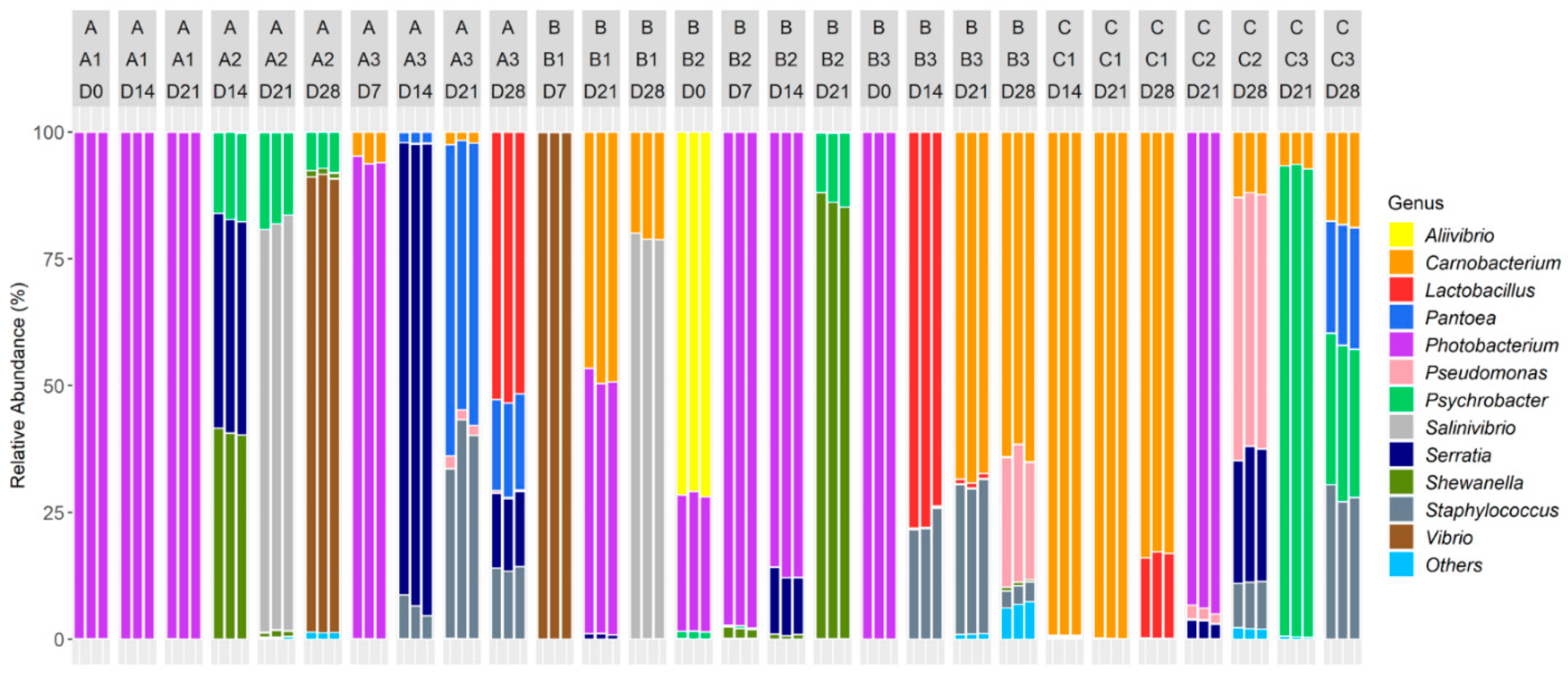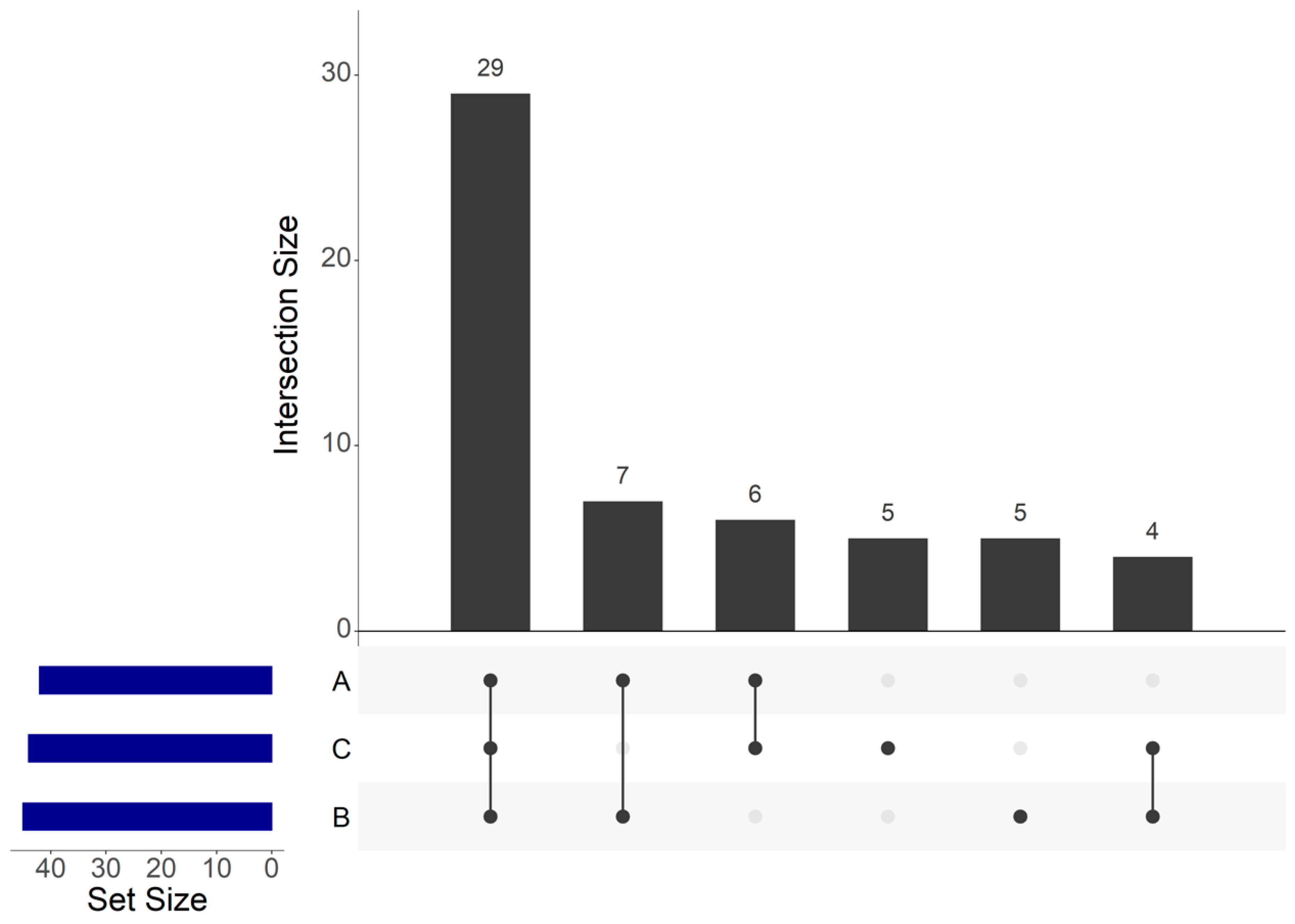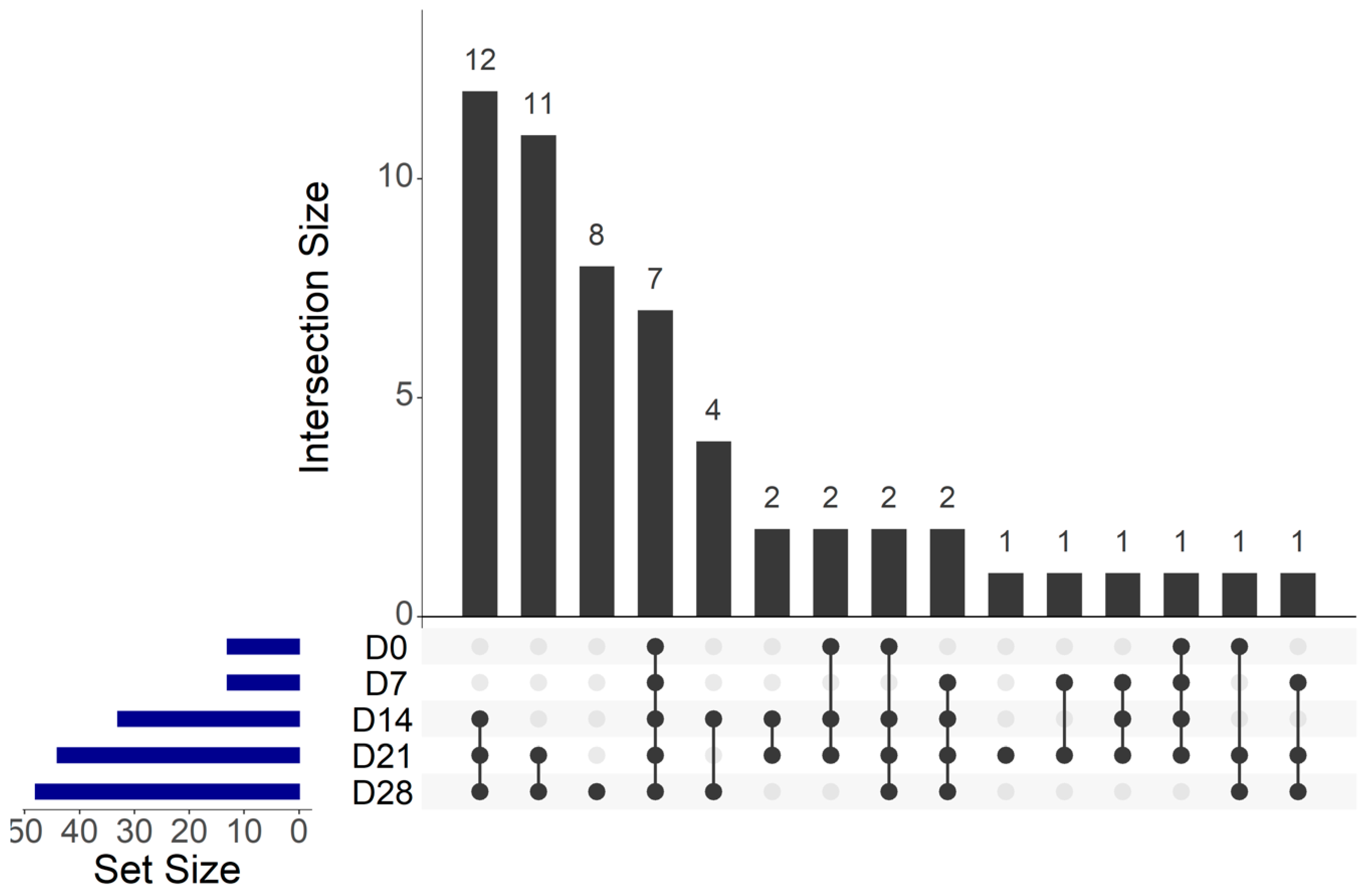Characterization of Bacterial Communities of Cold-Smoked Salmon during Storage
Abstract
:1. Introduction
2. Materials and Methods
2.1. Cold-Smoked Salmon Sampling
2.2. Bacterial Enumeration
2.3. Chemical Analyses
2.4. DNA Extraction
2.5. 16S rRNA Gene Sequencing
2.5.1. Library Preparation and Sequencing Using Illumina® MiSeq Platform
2.5.2. Sequencing Data Processing and Analyses
2.6. Statistical Analyses
3. Results
3.1. Microbiological Analyses
3.2. Chemical Analyses
3.3. Metabarcoding Analyses
4. Discussion
5. Conclusions
Supplementary Materials
Author Contributions
Funding
Institutional Review Board Statement
Informed Consent Statement
Data Availability Statement
Acknowledgments
Conflicts of Interest
References
- EUMOFA. The EU Fish Market 2020 Edition. Available online: https://www.eumofa.eu/fr/the-eu-fish-market-2020-edition-is-now-online (accessed on 5 February 2021).
- EUMOFA. Database. Available online: https://www.eumofa.eu/processing-yearly-comparison-beetween-ms (accessed on 21 January 2021).
- Gram, L.; Huss, H.H. Microbiological Spoilage of Fish and Fish Products. Int. J. Food Microbiol. 1996, 33, 121–137. [Google Scholar] [CrossRef]
- Wiernasz, N.; Cornet, J.; Cardinal, M.; Pilet, M.-F.; Passerini, D.; Leroi, F. Lactic Acid Bacteria Selection for Biopreservation as a Part of Hurdle Technology Approach Applied on Seafood. Front. Mar. Sci. 2017, 4. [Google Scholar] [CrossRef] [Green Version]
- Løvdal, T. The Microbiology of Cold Smoked Salmon. Food Control 2015, 54, 360–373. [Google Scholar] [CrossRef]
- Leroi, F.; Joffraud, J.J.; Chevalier, F. Effect of Salt and Smoke on the Microbiological Quality of Cold-Smoked Salmon during Storage at 5 °C as Estimated by the Factorial Design Method. J. Food Prot. 2000, 63, 502–508. [Google Scholar] [CrossRef] [PubMed]
- Leroi, F.; Joffraud, J.-J.; Chevalier, F.; Cardinal, M. Study of the Microbial Ecology of Cold-Smoked Salmon during Storage at 8 °C. Int. J. Food Microbiol. 1998, 39, 111–121. [Google Scholar] [CrossRef]
- Paludan-Müller, C.; Dalgaard, P.; Huss, H.H.; Gram, L. Evaluation of the Role of Carnobacterium Piscicola in Spoilage of Vacuum- and Modified-Atmosphere-Packed Cold-Smoked Salmon Stored at 5 °C. Int. J. Food Microbiol. 1998, 39, 155–166. [Google Scholar] [CrossRef]
- Joffraud, J.-J.; Cardinal, M.; Cornet, J.; Chasles, J.-S.; Léon, S.; Gigout, F.; Leroi, F. Effect of Bacterial Interactions on the Spoilage of Cold-Smoked Salmon. Int. J. Food Microbiol. 2006, 112, 51–61. [Google Scholar] [CrossRef]
- Illikoud, N.; Rossero, A.; Chauvet, R.; Courcoux, P.; Pilet, M.-F.; Charrier, T.; Jaffrès, E.; Zagorec, M. Genotypic and Phenotypic Characterization of the Food Spoilage Bacterium Brochothrix Thermosphacta. Food Microbiol. 2019, 81, 22–31. [Google Scholar] [CrossRef] [PubMed]
- Cambon-Bonavita, M.-A.; Lesongeur, F.; Menoux, S.; Lebourg, A.; Barbier, G. Microbial Diversity in Smoked Salmon Examined by a Culture-Independent Molecular Approach—A Preliminary Study. Int. J. Food Microbiol. 2001, 70, 179–187. [Google Scholar] [CrossRef]
- Giraffa, G.; Neviani, E. DNA-Based, Culture-Independent Strategies for Evaluating Microbial Communities in Food-Associated Ecosystems. Int. J. Food Microbiol. 2001, 67, 19–34. [Google Scholar] [CrossRef]
- Jaffrès, E.; Sohier, D.; Leroi, F.; Pilet, M.F.; Prévost, H.; Joffraud, J.J.; Dousset, X. Study of the Bacterial Ecosystem in Tropical Cooked and Peeled Shrimps Using a Polyphasic Approach. Int. J. Food Microbiol. 2009, 131, 20–29. [Google Scholar] [CrossRef] [PubMed]
- Postollec, F.; Falentin, H.; Pavan, S.; Combrisson, J.; Sohier, D. Recent Advances in Quantitative PCR (QPCR) Applications in Food Microbiology. Food Microbiol. 2011, 28, 848–861. [Google Scholar] [CrossRef] [PubMed]
- Bokulich, N.A.; Lewis, Z.T.; Boundy-Mills, K.; Mills, D.A. A New Perspective on Microbial Landscapes within Food Production. Curr. Opin. Biotechnol. 2016, 37, 182–189. [Google Scholar] [CrossRef] [Green Version]
- Ercolini, D. High-Throughput Sequencing and Metagenomics: Moving Forward in the Culture-Independent Analysis of Food Microbial Ecology. Appl. Environ. Microbiol. 2013, 79, 3148–3155. [Google Scholar] [CrossRef] [Green Version]
- Rachman, C.; Fourrier, A.; Sy, A.; Cochetiere, M.F.D.L.; Prevost, H.; Dousset, X. Monitoring of Bacterial Evolution and Molecular Identification of Lactic Acid Bacteria in Smoked Salmon during Storage. Le Lait 2004, 84, 145–154. [Google Scholar] [CrossRef] [Green Version]
- Olofsson, T.C.; Ahrné, S.; Molin, G. The Bacterial Flora of Vacuum-Packed Cold-Smoked Salmon Stored at 7 °C, Identified by Direct 16S RRNA Gene Analysis and Pure Culture Technique. J. Appl. Microbiol. 2007, 103, 109–119. [Google Scholar] [CrossRef] [PubMed]
- Møretrø, T.; Moen, B.; Heir, E.; Hansen, A.Å.; Langsrud, S. Contamination of Salmon Fillets and Processing Plants with Spoilage Bacteria. Int. J. Food Microbiol. 2016, 237, 98–108. [Google Scholar] [CrossRef] [PubMed] [Green Version]
- Jääskeläinen, E.; Jakobsen, L.M.A.; Hultman, J.; Eggers, N.; Bertram, H.C.; Björkroth, J. Metabolomics and Bacterial Diversity of Packaged Yellowfin Tuna (Thunnus albacares) and Salmon (Salmo salar) Show Fish Species-Specific Spoilage Development during Chilled Storage. Int. J. Food Microbiol. 2019, 293, 44–52. [Google Scholar] [CrossRef] [PubMed]
- Parlapani, F.F. Microbial Diversity of Seafood. Curr. Opin. Food Sci. 2020. [Google Scholar] [CrossRef]
- Chaillou, S.; Chaulot-Talmon, A.; Caekebeke, H.; Cardinal, M.; Christieans, S.; Denis, C.; Hélène Desmonts, M.; Dousset, X.; Feurer, C.; Hamon, E.; et al. Origin and Ecological Selection of Core and Food-Specific Bacterial Communities Associated with Meat and Seafood Spoilage. ISME J. 2015, 9, 1105–1118. [Google Scholar] [CrossRef] [PubMed] [Green Version]
- Afnor NF V01-003-(2018)-Food Traceability and Safety—Management and Hygiene—Guidelines for Implementing Microbiological Durability Tests—Chilled Perishable Foodstuffs. Available online: https://www.boutique.afnor.org/norme/nf-v01-003/tracabilite-et-securite-des-aliments-management-et-hygiene-lignes-directrices-pour-la-realisation-de-tests-de-vieillissement-mic/article/904498/fa191702 (accessed on 5 February 2021).
- Gardner, G.A. A Selective Medium for the Enumeration of Microbacterium Thermosphactum in Meat and Meat Products. J. Appl. Bacteriol. 1966, 29, 455–460. [Google Scholar] [CrossRef]
- Leroi, F.; Cornet, J.; Chevalier, F.; Cardinal, M.; Coeuret, G.; Chaillou, S.; Joffraud, J.-J. Selection of Bioprotective Cultures for Preventing Cold-Smoked Salmon Spoilage. Int. J. Food Microbiol. 2015, 213, 79–87. [Google Scholar] [CrossRef] [Green Version]
- Conway, E.J.; Byrne, A. An Absorption Apparatus for the Micro-Determination of Certain Volatile Substances. Biochem. J. 1933, 27, 419–429. [Google Scholar] [PubMed]
- Klindworth, A.; Pruesse, E.; Schweer, T.; Peplies, J.; Quast, C.; Horn, M.; Glockner, F.O. Evaluation of General 16S Ribosomal RNA Gene PCR Primers for Classical and Next-Generation Sequencing-Based Diversity Studies. Nucleic Acids Res. 2013, 41, e1. [Google Scholar] [CrossRef]
- Escudié, F.; Auer, L.; Bernard, M.; Mariadassou, M.; Cauquil, L.; Vidal, K.; Maman, S.; Hernandez-Raquet, G.; Combes, S.; Pascal, G. FROGS: Find, Rapidly, OTUs with Galaxy Solution. Bioinformatics 2017. [Google Scholar] [CrossRef] [PubMed]
- Magoč, T.; Salzberg, S.L. FLASH: Fast Length Adjustment of Short Reads to Improve Genome Assemblies. Bioinformatics 2011, 27, 2957–2963. [Google Scholar] [CrossRef]
- Mahé, F.; Rognes, T.; Quince, C.; de Vargas, C.; Dunthorn, M. Swarm v2: Highly-Scalable and High-Resolution Amplicon Clustering. PeerJ 2015, 3, e1420. [Google Scholar] [CrossRef] [Green Version]
- Rognes, T.; Flouri, T.; Nichols, B.; Quince, C.; Mahé, F. VSEARCH: A Versatile Open Source Tool for Metagenomics. PeerJ 2016, 4, e2584. [Google Scholar] [CrossRef] [PubMed]
- Bokulich, N.A.; Subramanian, S.; Faith, J.J.; Gevers, D.; Gordon, J.I.; Knight, R.; Mills, D.A.; Caporaso, J.G. Quality-Filtering Vastly Improves Diversity Estimates from Illumina Amplicon Sequencing. Nat. Methods 2013, 10, 57. [Google Scholar] [CrossRef] [PubMed]
- Wang, Q.; Garrity, G.M.; Tiedje, J.M.; Cole, J.R. Naïve Bayesian Classifier for Rapid Assignment of RRNA Sequences into the New Bacterial Taxonomy. Appl. Environ. Microbiol. 2007, 73, 5261–5267. [Google Scholar] [CrossRef] [Green Version]
- Cole, J.R.; Wang, Q.; Cardenas, E.; Fish, J.; Chai, B.; Farris, R.J.; Kulam-Syed-Mohideen, A.S.; McGarrell, D.M.; Marsh, T.; Garrity, G.M.; et al. The Ribosomal Database Project: Improved Alignments and New Tools for RRNA Analysis. Nucleic Acids Res. 2009, 37, D141–D145. [Google Scholar] [CrossRef] [Green Version]
- Quast, C.; Pruesse, E.; Yilmaz, P.; Gerken, J.; Schweer, T.; Yarza, P.; Peplies, J.; Glöckner, F.O. The SILVA Ribosomal RNA Gene Database Project: Improved Data Processing and Web-Based Tools. Nucleic Acids Res. 2013, 41, D590–D596. [Google Scholar] [CrossRef] [PubMed]
- R Core Team. R: A Language and Environment for Statistical Computing; R Foundation for Statistical Computing: Vienna, Austria, 2015; ISBN 3-900051-07-0. Available online: http://www.R-project.org (accessed on 5 February 2021).
- McMurdie, P.J.; Holmes, S. Phyloseq: An R Package for Reproducible Interactive Analysis and Graphics of Microbiome Census Data. PLoS ONE 2013, 8, e61217. [Google Scholar] [CrossRef] [PubMed] [Green Version]
- Lozupone, C.; Knight, R. UniFrac: A New Phylogenetic Method for Comparing Microbial Communities. Appl. Environ. Microbiol. 2005, 71, 8228–8235. [Google Scholar] [CrossRef] [Green Version]
- Lex, A.; Gehlenborg, N.; Strobelt, H.; Vuillemot, R.; Pfister, H. UpSet: Visualization of Intersecting Sets. IEEE Trans. Vis. Comput. Graph. 2014, 20, 1983–1992. [Google Scholar] [CrossRef]
- Conway, J.R.; Lex, A.; Gehlenborg, N. UpSetR: An R Package for the Visualization of Intersecting Sets and Their Properties. Bioinformatics 2017, 33, 2938–2940. [Google Scholar] [CrossRef] [Green Version]
- Gram, L.; Dalgaard, P. Fish Spoilage Bacteria—Problems and Solutions. Curr. Opin. Biotechnol. 2002, 13, 262–266. [Google Scholar] [CrossRef]
- Remenant, B.; Jaffrès, E.; Dousset, X.; Pilet, M.-F.; Zagorec, M. Bacterial Spoilers of Food: Behavior, Fitness and Functional Properties. Food Microbiol. 2015, 45, 45–53. [Google Scholar] [CrossRef] [PubMed]
- Jørgensen, L.V.; Huss, H.H.; Dalgaard, P. The Effect of Biogenic Amine Production by Single Bacterial Cultures and Metabiosis on Cold-Smoked Salmon. J. Appl. Microbiol. 2000, 89, 920–934. [Google Scholar] [CrossRef] [PubMed]
- Odeyemi, O.A.; Burke, C.M.; Bolch, C.C.J.; Stanley, R. Seafood Spoilage Microbiota and Associated Volatile Organic Compounds at Different Storage Temperatures and Packaging Conditions. Int. J. Food Microbiol. 2018, 280, 87–99. [Google Scholar] [CrossRef]
- Joffraud, J.-J.; Leroi, F.; Roy, C.; Berdague, J.L. Characterisation of Volatile Compounds Produced by Bacteria Isolated from the Spoilage Flora of Cold-Smoked Salmon. Int. J. Food Microbiol. 2001, 66, 175–184. [Google Scholar] [CrossRef] [Green Version]
- Stohr, V.; Joffraud, J.J.; Cardinal, M.; Leroi, F. Spoilage Potential and Sensory Profile Associated with Bacteria Isolated from Cold-Smoked Salmon. Food Res. Int. 2001, 34, 797–806. [Google Scholar] [CrossRef] [Green Version]
- Afnor NF V45-065-(2012)-Pre-Packaged and Prepared Foods—Processed Products from Fisheries and Aquaculture—Smoked Salmon. Available online: https://www.boutique.afnor.org/norme/nf-v45-065/produits-transformes-issus-de-la-peche-et-de-l-aquaculture-saumon-fume/article/798137/fa175285 (accessed on 5 February 2021).
- Ibrahim, S.; Zahri, K.N.M.; Convey, P.; Khalil, K.A.; Gomez-Fuentes, C.; Zulkarnain, A.; Alias, S.A.; González-Rocha, G.; Ahmad, S.A. Optimisation of Biodegradation Conditions for Waste Canola Oil by Cold-Adapted Rhodococcus Sp. AQ5-07 from Antarctica. Electron. J. Biotechnol. 2020, 48, 1–12. [Google Scholar] [CrossRef]
- Peterson, M.E.; Pelroy, G.A.; Paranjpye, R.N.; Poysky, F.T.; Almond, J.S.; Eklund, M.W. Parameters for Control of Listeria Monocytogenes in Smoked Fishery Products: Sodium Chloride and Packaging Method. J. Food Prot. 1993, 56, 938–943. [Google Scholar] [CrossRef]
- Guilbaud, M.; Chafsey, I.; Pilet, M.-F.; Leroi, F.; Prévost, H.; Hébraud, M.; Dousset, X. Response of Listeria Monocytogenes to Liquid Smoke. J. Appl. Microbiol. 2008, 104, 1744–1753. [Google Scholar] [CrossRef] [Green Version]
- Neunlist, M.R.; Ralazamahaleo, M.; Cappelier, J.-M.; Besnard, V.; Federighi, M.; Leroi, F. Effect of Salting and Cold-Smoking Process on the Culturability, Viability, and Virulence of Listeria Monocytogenes Strain Scott A. J. Food Prot. 2005, 68, 85–91. [Google Scholar] [CrossRef] [PubMed]
- Brillet, A.; Pilet, M.-F.; Prevost, H.; Cardinal, M.; Leroi, F. Effect of Inoculation of Carnobacterium Divergens V41, a Biopreservative Strain against Listeria Monocytogenes Risk, on the Microbiological, Chemical and Sensory Quality of Cold-Smoked Salmon. Int. J. Food Microbiol. 2005, 104, 309–324. [Google Scholar] [CrossRef] [Green Version]
- Macé, S.; Joffraud, J.-J.; Cardinal, M.; Malcheva, M.; Cornet, J.; Lalanne, V.; Chevalier, F.; Sérot, T.; Pilet, M.-F.; Dousset, X. Evaluation of the Spoilage Potential of Bacteria Isolated from Spoiled Raw Salmon (Salmo Salar) Fillets Stored under Modified Atmosphere Packaging. Int. J. Food Microbiol. 2013, 160, 227–238. [Google Scholar] [CrossRef] [Green Version]
- Bukin, Y.S.; Galachyants, Y.P.; Morozov, I.V.; Bukin, S.V.; Zakharenko, A.S.; Zemskaya, T.I. The Effect of 16S RRNA Region Choice on Bacterial Community Metabarcoding Results. Sci. Data 2019, 6. [Google Scholar] [CrossRef] [PubMed] [Green Version]
- Wiernasz, N.; Leroi, F.; Chevalier, F.; Cornet, J.; Cardinal, M.; Rohloff, J.; Passerini, D.; Skırnisdóttir, S.; Pilet, M.-F. Salmon Gravlax Biopreservation with Lactic Acid Bacteria: A Polyphasic Approach to Assessing the Impact on Organoleptic Properties, Microbial Ecosystem and Volatilome Composition. Front. Microbiol. 2020, 10. [Google Scholar] [CrossRef] [PubMed]
- Parlapani, F.F.; Michailidou, S.; Anagnostopoulos, D.A.; Sakellariou, A.K.; Pasentsis, K.; Psomopoulos, F.; Argiriou, A.; Haroutounian, S.A.; Boziaris, I.S. Microbial Spoilage Investigation of Thawed Common Cuttlefish (Sepia Officinalis) Stored at 2 °C Using next Generation Sequencing and Volatilome Analysis. Food Microbiol. 2018, 76, 518–525. [Google Scholar] [CrossRef] [PubMed]
- Walterson, A.M.; Stavrinides, J. Pantoea: Insights into a Highly Versatile and Diverse Genus within the Enterobacteriaceae. FEMS Microbiol. Rev. 2015, 39, 968–984. [Google Scholar] [CrossRef] [PubMed] [Green Version]
- Skrodenytė-Arbačiauskienė, V.; Sruoga, A.; Butkauskas, D.; Skrupskelis, K. Phylogenetic Analysis of Intestinal Bacteria of Freshwater Salmon Salmo Salar and Sea Trout Salmo Trutta Trutta and Diet. Fish. Sci. 2008, 74, 1307–1314. [Google Scholar] [CrossRef]
- Miranda, C.D.; Zemelman, R. Bacterial Resistance to Oxytetracycline in Chilean Salmon Farming. Aquaculture 2002, 212, 31–47. [Google Scholar] [CrossRef]
- González-Rodrı́guez, M.-N.; Sanz, J.-J.; Santos, J.-Á.; Otero, A.; Garcı́a-López, M.-L. Numbers and Types of Microorganisms in Vacuum-Packed Cold-Smoked Freshwater Fish at the Retail Level. Int. J. Food Microbiol. 2002, 77, 161–168. [Google Scholar] [CrossRef]
- Silbande, A.; Adenet, S.; Chopin, C.; Cornet, J.; Smith-Ravin, J.; Rochefort, K.; Leroi, F. Effect of Vacuum and Modified Atmosphere Packaging on the Microbiological, Chemical and Sensory Properties of Tropical Red Drum (Sciaenops Ocellatus) Fillets Stored at 4 °C. Int. J. Food Microbiol. 2018, 266, 31–41. [Google Scholar] [CrossRef]
- Rouger, A.; Moriceau, N.; Prévost, H.; Remenant, B.; Zagorec, M. Diversity of Bacterial Communities in French Chicken Cuts Stored under Modified Atmosphere Packaging. Food Microbiol. 2018, 70, 7–16. [Google Scholar] [CrossRef] [PubMed]
- Stellato, G.; Storia, A.L.; Filippis, F.D.; Borriello, G.; Villani, F.; Ercolini, D. Overlap of Spoilage-Associated Microbiota between Meat and the Meat Processing Environment in Small-Scale and Large-Scale Retail Distributions. Appl. Environ. Microbiol. 2016, 82, 4045–4054. [Google Scholar] [CrossRef] [Green Version]







| Factory | Production | Origin/Label | Use-by-Date |
|---|---|---|---|
| A | A1 | Scotland | 13 March 2019 |
| A2 | Norway | 13 March 2019 | |
| A3 | Norway | 07 March 2019 | |
| B | B1 | Scotland | 09 March 2019 |
| B2 | Norway | 09 March 2019 | |
| B3 | Scotland/Label Rouge | 04 March 2019 | |
| C | C1 | Scotland | 15 March 2019 |
| C2 | Norway | 15 March 2019 | |
| C3 | Ireland/Organic | 09 March 2019 |
| Factory | Salmon | Date | Observed OTUs | Shannon Index |
|---|---|---|---|---|
| A | A1 | D0 | 4.000 ± 0.000 | 0.006 ± 0.001 |
| A | A1 | D14 | 1.333 ± 0.577 | 0.000 ± 0.001 |
| A | A1 | D21 | 2.667 ± 1.155 | 0.004 ± 0.002 |
| A | A2 | D14 | 12.667 ± 0.577 | 1.130 ± 0.018 |
| A | A2 | D21 | 12.000 ± 1.000 | 0.576 ± 0.020 |
| A | A2 | D28 | 18.667 ± 1.528 | 0.501 ± 0.016 |
| A | A3 | D7 | 4.000 ± 1.000 | 0.221 ± 0.023 |
| A | A3 | D14 | 8.000 ± 1.000 | 0.400 ± 0.065 |
| A | A3 | D21 | 9.000 ± 0.000 | 0.902 ± 0.010 |
| A | A3 | D28 | 16.333 ± 1.155 | 1.333 ± 0.018 |
| B | B1 | D7 | 3.667 ± 1.155 | 0.008 ± 0.001 |
| B | B1 | D21 | 11.000 ± 1.000 | 0.807 ± 0.006 |
| B | B1 | D28 | 5.667 ± 1.155 | 0.518 ± 0.012 |
| B | B2 | D0 | 7.333 ± 1.528 | 0.664 ± 0.006 |
| B | B2 | D7 | 7.000 ± 1.000 | 0.135 ± 0.013 |
| B | B2 | D14 | 7.333 ± 0.577 | 0.428 ± 0.026 |
| B | B2 | D21 | 13.000 ± 1.732 | 0.537 ± 0.040 |
| B | B3 | D0 | 2.333 ± 0.577 | 0.002 ± 0.002 |
| B | B3 | D14 | 12.000 ± 0.000 | 0.678 ± 0.054 |
| B | B3 | D21 | 14.000 ± 1.000 | 1.074 ± 0.022 |
| B | B3 | D28 | 17.333 ± 0.577 | 1.080 ± 0.027 |
| C | C1 | D14 | 10.333 ± 0.577 | 0.060 ± 0.002 |
| C | C1 | D21 | 7.000 ± 1.000 | 0.054 ± 0.005 |
| C | C1 | D28 | 11.667 ± 1.155 | 0.539 ± 0.002 |
| C | C2 | D21 | 13.667 ± 1.528 | 0.337 ± 0.062 |
| C | C2 | D28 | 17.667 ± 1.528 | 1.744 ± 0.007 |
| C | C3 | D21 | 8.333 ± 2.309 | 0.816 ± 0.014 |
| C | C3 | D28 | 20.667 ± 0.577 | 1.800 ± 0.004 |
Publisher’s Note: MDPI stays neutral with regard to jurisdictional claims in published maps and institutional affiliations. |
© 2021 by the authors. Licensee MDPI, Basel, Switzerland. This article is an open access article distributed under the terms and conditions of the Creative Commons Attribution (CC BY) license (http://creativecommons.org/licenses/by/4.0/).
Share and Cite
Maillet, A.; Denojean, P.; Bouju-Albert, A.; Scaon, E.; Leuillet, S.; Dousset, X.; Jaffrès, E.; Combrisson, J.; Prévost, H. Characterization of Bacterial Communities of Cold-Smoked Salmon during Storage. Foods 2021, 10, 362. https://doi.org/10.3390/foods10020362
Maillet A, Denojean P, Bouju-Albert A, Scaon E, Leuillet S, Dousset X, Jaffrès E, Combrisson J, Prévost H. Characterization of Bacterial Communities of Cold-Smoked Salmon during Storage. Foods. 2021; 10(2):362. https://doi.org/10.3390/foods10020362
Chicago/Turabian StyleMaillet, Aurélien, Pauline Denojean, Agnès Bouju-Albert, Erwann Scaon, Sébastien Leuillet, Xavier Dousset, Emmanuel Jaffrès, Jérôme Combrisson, and Hervé Prévost. 2021. "Characterization of Bacterial Communities of Cold-Smoked Salmon during Storage" Foods 10, no. 2: 362. https://doi.org/10.3390/foods10020362
APA StyleMaillet, A., Denojean, P., Bouju-Albert, A., Scaon, E., Leuillet, S., Dousset, X., Jaffrès, E., Combrisson, J., & Prévost, H. (2021). Characterization of Bacterial Communities of Cold-Smoked Salmon during Storage. Foods, 10(2), 362. https://doi.org/10.3390/foods10020362







